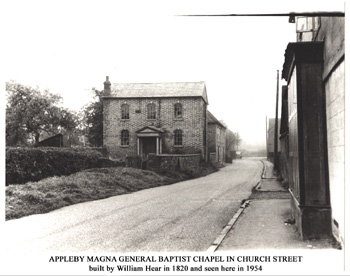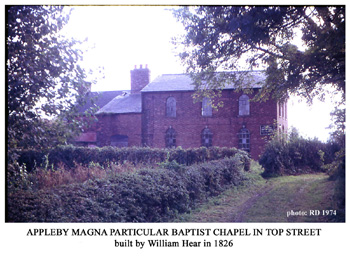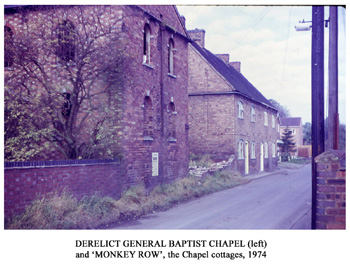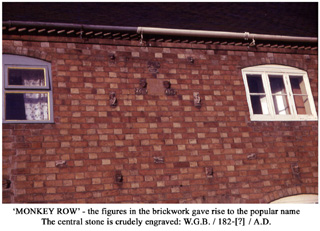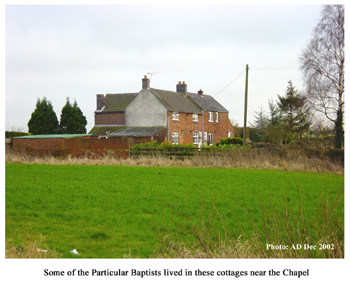Appleby History > In Focus > 25 - Chapels
Chapter 25
Chapels: Nonconformists in Appleby
by Richard Dunmore
A Period of Religious Turmoil
In 1509, Henry VIII inherited an unreformed Catholic Church under the controlling authority of Rome. During the 16th and 17th centuries, religious observance in England passed through a period of massive upheaval and change as Protestant groups and Catholics vied for control. By the time of Charles II, Roman Catholicism, regarded as a threat to the state, had been firmly suppressed. A reformed Church of England was established by the Act of Uniformity of 1662. With the introduction of the Book of Common Prayer at the same date, standard services were imposed for the foreseeable future and non-conformist meetings for prayer or worship were suppressed. Under William and Mary the Act of Toleration of 1689 allowed non-conformists to meet in registered Meeting Houses, but Roman Catholics continued to be heavily penalised. So Baptists, Quakers, Presbyterians and other independent congregations were now legitimised.
Appleby Church in the 17th Century
One consequence of the Parliamentary victory in the Civil War was that Abraham Mould, the rector of Appleby appointed in 1642, lost his living in 1655 to Jonathan Clay a Presbyterian minister. However he retrieved it following the Restoration of Charles II in 1660. Jonathan Clay appears, at least outwardly, to have accepted the restored Church of England as he was subsequently appointed to the rectory at Heather, a much poorer benefice (1).
After the 1662 Act of Uniformity, enquiries about non-conformist activity were made by Bishops and Archdeacons of parsons or their Churchwardens. In 1669 the Archdeacon of Leicester received the following certificate from the Appleby Churchwardens:
Appleby: the minister being sicke the churchwardens certifie yt there is noe conventicle within this parish. Samuel Torrell and John Hunt Churchwardens. (2)
A conventicle was a meeting house used by dissenters and at this time their meetings were illicit. After the 1689 Act, dissenters in many parts of the country were quick to get their houses licensed for non-conformist meetings and within a few years they set about building their own chapels (3). Any support in Appleby for Jonathan Clay's Presbyterianism seems to have vanished with his departure. There is no evidence of any dissenting group in Appleby until the early nineteenth century.
Apathy rather than Dissent in Appleby
The late Stuart period witnessed widespread apathy towards the Church and defiance of compulsory attendance. The Act of Toleration of 1689, by permitting the setting up of non-conformist congregations, loosened the parson's power over religious observance as his parishioners could attend elsewhere, and many avoided religious services altogether. So in Appleby dislike of, or disillusionment with, the established Church seems to have taken the form of apathy towards all religion.
A knock-on effect of this was that upkeep of many Church buildings suffered for years to come. Churches were at a low ebb throughout the 17th and 18th centuries. Without the support of the laity, Church property generally was neglected. On one occasion, pigs got into Appleby churchyard through broken-down walls and entered the Church itself during divine service. The Church interior was no better. The flagon for communion wine was said to be a 'base quart pott' and there was a shortage of seats causing the children to sit in the chancel where they were 'want to bee very disorderly by reason of the remoteness of the place' (4).
There seem to have been two reactions to the precarious state into which Appleby Church had fallen, both in regard of its crumbling building and in its failing mission to the people of the parish.
Church Building Restoration
Firstly, the more responsible members of the gentry eventually set about putting their house of worship in order. This led to extensive restoration work to the Parish Church carried out in the period 1827-32. The catalyst for this activity was Mrs Mary Moore (1757-1823) widow of Revd. John Moore (1749-1814) of Appleby House (the early Hall). She had been concerned about the state of the Church during her lifetime and in her will left the sum of £1000 towards Church restoration. This project was undertaken with some enthusiasm by the Rector of Appleby, Revd. Thomas Jones, who raised a similar sum by public subscription (5) (6). [I will write about 19th century restoration work on Appleby Church in the next article.] Mrs Moore must also have been well aware of a non-conformist movement growing in the village partly as a result of the disaffection of parishioners with the Church.
The Baptist Movement
So the second development was an initiative of the Baptist 'cause' which in due course led to the building of two chapels to meet the spiritual needs of the 'perishing' people of 'this dark place'. The use of this form of language (see below) conveys the urgency felt by the Baptists that all people should be made aware of their sins and taught about the redemption available for believers. The Church's complacent attitude was seen as shamefully inadequate.
Particular Baptist beliefs were equivalent to Calvinism: salvation from original sin is available to particular individuals chosen by God. The point of contention is that this implies that Christ died not for all, but only for the chosen 'elect'. The dispute with the General Baptist Minister from Austrey, Mr Barnes, which led to the division of the Baptists in Appleby (see below) is quite likely to have centred on this doctrine.
The driving force behind the Baptist movement in the village was William Hear (pronounced 'hair') a Particular Baptist adherent from Birmingham who had been born in Appleby. The Appleby Particular Baptist Church Book narrates the development of the Baptist movement in the village, the split between the General and Particular Baptists and the progress of the Particular Baptists thereafter (7). There is no indication of authorship although the initial narrative (up to 1825) may be by Mr Hear himself.
The Appleby Particular Baptist Church Book
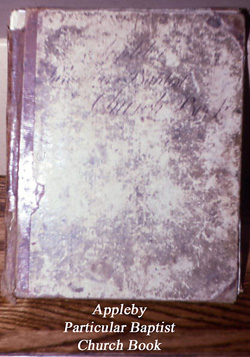 |
 |
 Click images for larger views |
The Particular Baptist Cause, here, was brought about in the following manner -
About the Year 1816 It pleased the Lord in his kind providence, to visit this dark place by putting into the heart of his servant Mr Wm. Hear to return from Birmingham (where he then resided and had stood for many years a member in the Particular Baptist Church Bond Street) to this the place of his nativity, that might make him instrumental in rearing up a building not made with hands, of which it afterward appeared, he was the chief instrumental cause.
Note: the story of the foundation of the Baptist Chapels at Appleby was related in one continuous narrative. For the sake of clarity, I have divided it into paragraphs and inserted suitable small headings and comments. The original text is in italics. It continues:
House Meetings
Having been taught the value of his own Soul, and to know his acceptance through the Redeemer, his heart like all Gods people, expanded with pity towards his perishing Neighbours, he therefore opened his House for prayer, And as there was none of his own persuasion within seven or eight miles, and no one to stand by him, he invited Mr Barnes the General Baptist Minister from Austrey, who came and had the House Licensed, and began to Preach to the people, who seemed inclined to hear.
Preaching
Mr Hear also laboured amongst them in expounding the word to them on week day evening and sabbath morning opportunities, and though he had never, publickly addressed any people till he came here, and even then with many a fear lest he should not lead the people aright, but the Lord looks not at the outward appearance, nor at the weakness of the instruments, but at the heart,
Conversions
thus between Mr Hear & Mr Barnes the people continued to hear the word preached or expoun[d]ed, and in the use of the means, one and another were convinced of their lost condition, and were made willing in the day of his power, to renounce the world, with their own righteousness, and to embrace the Lord Jesus Christ as a whole Saviour, and his Righteousness, as the only ground of their Justification before a Holy God, and most of them do confess, that Mr Hear was made the great instrumental cause of their deliverance out of their spiritual Bondage.
Persecution
But it is said, they that live after the flesh, will persecute them that live after the Spirit, and so it was here, they met with very great opposition from the most oppulent Inhabitants, and experienced the truth of that absolute promise viz. all they that will live Godly in Christ Jesus shall suffer persecution, Mr Hear and another were turned out of their Houses and another put out of his School, and others threatened with loss of their places of employ if they went to hear them, nevertheless the Cause went on and prospered, the Congregations increased;
The Building of the General Baptist Chapel
and Mr Hear purchased some premises in the Church Street for the purpose of erecting a Chapel, to Worship God in, but in some conversation which passed between him and Mr Barnes, he offered them the premises, which they accepted, and a Chapel was erected, which together, became the Property of the General Baptists, and those whom the Lord had called stood as Members in the General Baptist Church at Austrey, but as they and Mr Hear so widely differed in their opinions, he never stood a member with them, yet as he had a greater love for Souls than Sentiments, he willingly united with them in striving to promote the Glory of God and the good of immortal Souls.
Dispute and Separation
But after some time it came to pass that there arose many disputes between the friends at Appleby and Mr Barnes, respecting the grand doctrines of the Gospel, some of which he totally rejected and called despicable doctrines, and others were left out and despised, and after some time he advised us to leave them and become a little band of our own. We therefore seperated [sic] from them in as orderly a manner as possible, and that for conscience sake, that we might enjoy our own sentiments as far as they agreed with the word of God.
Land for a Second Chapel
We have therefore met at Mr Hears House ever since which is upwards of three years, and have procured a Minister as often as we could get one and our circumstances would admit, and when we could not get one Mr Hear expoun[d]ed the word of God to us, so that we may truly say, hitherto hath the Lord helped us. Mr Hear has since given us a piece of Land, to the value of 210£ which is vested in the hands of eighteen Trustees of the Particular Baptist persuasion, for the purpose of Erecting a Chapel, and the remainder of the Land for the use of the Church for ever.
Thus hath the arm of the Lord been revealed, so that in this dark place the Lord hath collected together eleven Baptised Men and Women who were joined together in Church Fellowship by Mr Morgan of Birmingham, on the 10th of August 1825.
[in different handwriting – Mr Morgan's:]
The above Case, I believe to be substantially correct -
Thomas Morgan – Moseley, Near Birmingham,
October 1, 1825
Biblical Style
It is interesting that the above account was written in a rather ponderous quasi-biblical style. The phraseology is redolent of Authorised Version biblical language. We are told, not that Mr Hear was born in Appleby but, that it was the place of his nativity. Appleby itself is described as this dark place, implying spiritual neglect on the part of the established church locally. Other examples of such phrases are: laboured amongst them; after some time it came to pass; and thus hath the arm of the Lord been revealed.
Persecution and Conflict
The account, perhaps devised to be read at meetings in later years, has the dramatic elements of persecution and conflict, narrative ingredients also to be found in the Bible.
There was very great opposition from the most oppulent Inhabitants ... The 'opulent inhabitants' were of course the squire George Moore and the Revd Thomas Jones, Rector of Appleby 1793-1830, whose control of the village, both secular and religious, was being challenged. It was true of course that the local church was in bad repair. Since the enclosure of 1772, it was also true that the rector was seen as a wealthy gentleman with little concern for the poorer parishioners.
Mr Hear and another were turned out of their Houses and another put out of his School, and others threatened with loss of their places of employ... George Radford, baptised at Appleby Church 1790 and appointed Writing Master in 1809, was dismissed from his post at Appleby Grammar School as early as 1810. In George Radford it is possible to detect a dissenting voice in the village well before William Hear's return from Birmingham in 1816, with money to build a chapel (or indeed two). George had apparently also been to Birmingham, where he met his wife Sarah. She was the daughter of Sarah and Charles Walden, Mechanic, of Birmingham. George and Sarah's daughter Jane, born Oct 2nd 1821, was listed in the Particular Baptist Chapel Births Register (8) (9).
The falling out with Mr Barnes and the General Baptists is couched in polite but self-justifying words covering the bitterness: there arose many disputes between the friends at Appleby and Mr Barnes ...
[some doctrines] he totally rejected and called despicable ... ; after some time he advised us to leave them and become a little band on our own. This led to the separated group building their own chapel.
Following the above introductory narrative, the Church Book consists of a logbook or diary, written in different hands, recording the events of the Chapel's life in varying detail up to the 1850s. Thomas Morgan who witnessed the narrative was a respected Baptist minister in Birmingham (10). He was subsequently entrusted with the chapel deeds:
1827 Octr. 2nd The Trust Deed belonging to this chapel left in the hands of Rev T Morgan of Birmingham.
Building the Particular Baptist Chapel
There must have been great disappointment at the loss of the first chapel to the General Baptists when the group split. So the building of the second chapel, for the 'little band' of Particular Baptists, must have been a cause of great satisfaction to them. Its construction took less than nine months:
1825 Oct 11th: Began to build the Meeting House ...
1826 July 5th: The Meeting House was opened by the Rev. T. Morgan of Birmingham P.B. Preached from John 14C.1v Let not your heart be troubled: ye believe in God, believe also in me. Service commenced at 11 o'clock. - In the evening the Rev. T Eagleton of Birmingham Independent; Preached from .. three passages of scripture ....
July 16th Began a Sabbath School.
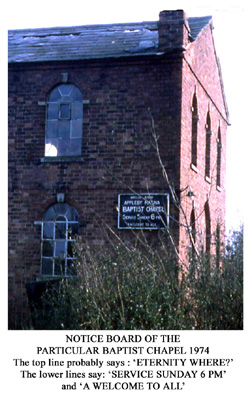 |
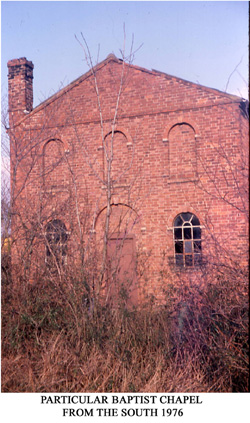 |
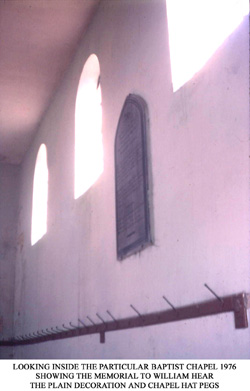 Click images for larger views |
Ministers
There were difficulties in obtaining and keeping a minister for the chapel right from the start. The split from Mr Barnes and the General Baptists after the building of the first chapel demonstrates how strict this group were about the beliefs of their members, even more so of their minister.
1825 Sept 24th: Mr Nicholas was sent by the Home Missionary Society, who engaged 20£ per Annum and the church raised him 25£ making together 45£ ...
1826 Sept 24th: Mr Nicholas went away not being accepted either by the Church or the people...
Sept 29th: Mr Barnett from Gloucestershire came among us upon trial, he had a Wife but no family, had 20£ from the Society and 25£ from the Church.
John and Lois Barnett stayed and three children were born during their time in Appleby (9). However, Mr Barnett had differences from time to time with the members, which after 12 years led to his departure.
The Revd John Barnett preached his last Sermon amongst us June 3rd 1838 ... having been here upwards of twelve Years and the ordained Pastor of this Church eleven Years. But in consequence of the declining state of the Cause partly from a Connexion that was formed by Mr Barnett and a desire he had to supply the General Baptist Branch Church at Measham (whose sentiments as a Minister seem'd to be more in accordance with them than with us) and partly from other incidental causes which were calculated and did in reality militate very materially against the progressive interest of the Particular Baptist Cause in this place and the Cause that lays near our heart – We the Deacons with the Majority of the Church deem'd it prudent to advise him, i.e. Mr Barnett, to withdraw his labour which after some strong contention he did ....
Perhaps not surprisingly, there were difficulties in finding a suitable replacement and the members had to rely on the services of William Hear while a part-time minister was engaged.
1842 July 18: At a church meeting held this night it was unanimously agreed to invite Mr P.C.Bissell of Birmingham to accept the Pastoral charge over us....
Augst. 15 Our Brother Bissell accepted the invitation on condition that it should be discretional with him as to the frequency of his visits and during his absence the Church would find supplies or hold meetings for reading and prayers.
By the following March Mr Samuel Webb, Baptist Minister late of Oadby Leicestershire, was invited and accepted the work of minister in connexion with Brother Bissell, which seems to imply that Mr Bissell's occasional ministry continued.
Strict Rules of Behaviour
The exclusive nature of the Particular Baptists becomes clear, not only concerning their beliefs, but from their strict standards of behaviour. Good behaviour was required to demonstrate complete regeneration from the condition of 'original sin' before conversion. Here is just one example.
1827 April 3rd: John Wilkins applied for baptism. Mr Barnett & Mr Hear appointed to visit him...
May 1st: John Wilkins' case hardly satisfactory; the friends requested to make all possible inquiry respecting his character ...
June 5th: John Wilkins appears to be very humble and penitent, but he has contracted debts at Taverns and the brethren are afraid that he will hardly conquer the sin of drunkness [sic] it “so easily besets him”. Brothers W Taylor & Jno. Radford appointed to admonish him, & inform him that his case is not given up...
July 3rd ... the brethren desired to watch and encourage him...
July 31st: John Wilkins still anxious to join the Church: Brothers Hear & Jas. Radford to converse with him respecting his debts & imprisonment by his Master.
1828 Jany. 20th John Wilkins came before the Church and was recd [received].
August 26: A report was brought that John Wilkins had been intoxicated. Mr Hear & Barnett appointed to visit him.
Sepr. 16: John Wilkins manifests true repentance and is permitted to remain in Church fellowship.
Octr. 14: John Wilkins has withdrawn from the Church.
This rather sad story, which dragged on for another year before Wilkins was finally excluded, shows how those strongly holding 'particular' beliefs found themselves required to monitor the behaviour of others, remonstrate with them and decide whether they were acceptable as members or fit to continue to be so. Although there was clearly a desire to act charitably, their controlling and judgmental attitude, guided by their beliefs, often seems to have been at odds with this.
Chapel Properties
Both Baptist groups built houses near their chapel buildings. In Church Street the General Baptists built a small row of cottages, known locally as Monkey Row from the curious pot figures built into the facing brickwork (see picture). In 1831 these houses were owned by the General Baptist Society.
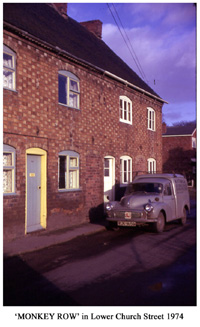 |
Similarly some of the cottages close to the Particular Baptist Chapel, in Top Street and at the corner of Botts Lane, were owned and occupied by chapel members, including some of the Haywood family (11).
Membership Numbers
Towards the end of the Church Book, entries are sporadic but at one point membership is stated to have been 26. Another idea of the size of the membership is given by the Register of Births which lists the children born to their families between 1818 and 1837. Minister John Barnett and the Deacons recorded 35 children in detail in the register which was submitted with a signed statement of accuracy to the Commissioners enquiring into the State, Custody and Authenticity of Non-Parochial Registers. This was done as a preliminary exercise to the national registration of Births, Deaths and Marriages, which began in 1837. The actual register appears to have been started in 1827 by Mr Barnett on his appointment as minister. He first entered the details of children born since 1818, which he must have sought out from the families concerned, marking each: taken from a book kept in the family by J Barnett Pastor of the Church.
Ecclesiastical Census 1851
An unique Ecclesiastical Census took place alongside the National Census on 30th March 1851 (12). Hope Chapel, as the Particular Baptist Chapel was then called, recorded 22 free sittings (seats) no 'other' (paid) sittings and the general congregation was 18 in the morning and 40 in the evening. The entry for Sunday School attendance was left blank, suggesting that there was none. The return was witnessed by William Orchard of Newton Regis in his capacity as Deacon. Incidentally, the Chapel later became known colloquially as Eternity Where? from the message on its notice board.
By comparison, John Barnes completed the return for the General Baptist Chapel recording 20 free sittings, 'other sittings' blank and there was room for another 30 persons standing. Average attendance was said to be 80 morning or evening (two sets of figures were given, perhaps indicating that services alternated weekly). How 80 people got into the spaces described, I cannot work out! No Sunday School figures were submitted by Mr Barnes either. Average attendance at the Wesleyan Chapel (see below) which held an evening service was 52, the chapel having 60 free sittings and 8 'other'.
It is difficult to know what to make of these figures as some appear to be rather inaccurate estimations, especially those of Mr Barnes.
Hagar's 1849 directory helpfully lists Places of Worship and gives more details (13).
St Michael's Church. - Echalaz, Rev John Manuel, M.A. rector. Service, 11 am and 3 pm.
General Baptist Chapel. - Barnes Rev.J. minister. Service, 6 pm.
Particular Baptist Chapel – Service, 6 pm.
Wesleyan Methodist Chapel. - circuit preachers. Services, 9 am and 6 pm.
Wesleyan Methodist Chapel
Few written records exist for the Wesleyan Methodist Chapel which was built in Golden Way (Rectory Lane) in 1840. This information comes from the Ecclesiastical Census (12). The building still stands and is used as a private house. Clearly, this chapel became established in the local Wesleyan Methodist Circuit (Ashby?) very quickly after its construction. However of the three Appleby chapels, it was the first to close.
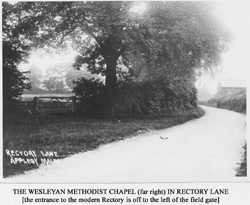 |
 Click images for larger views |
Last Days
All three chapels are mentioned in Kelly's Leicestershire Directory of 1912 but in the 1925 edition only the two Baptist chapels are named suggesting closure of the Wesleyan chapel around the time of the First World War. Maybe the Methodist Circuit was affected by the loss of men which so badly affected the country generally. The chapel was subsequently converted into a bungalow for residential use. More recent alterations have included the installation of Gothic style windows and coloured glass, presumably to suggest its former purpose. However, the above photographs show that the building was originally quite simple in both structure and decoration.
The General Baptist Chapel in Church Street was the next to close, in the inter-war years. It was used from 1940 – 57 to provide relief for overcrowding in the small Church School (now the Church Hall), adapted as a classroom for the Infants Class (14). Dilapidated and dangerous, it was demolished in the mid-1970s.
The Particular Baptist Chapel has also become a dwelling incorporating the old minister's house, having survived as a Meeting House for almost 150 years. The last services were held there in 1972. The original trust deed, conveying the site from William Hear to the trustees in 1824, had by 1974 passed into the hands of the Baptist Union Corporation Ltd. In the absence of trustees or church members, the Charity Commission approved the sale of the property, with the proceeds going to the Particular Baptist Fund in accordance with the original trust deed (15). In the brief period between closure and sale, the chapel provided accommodation for the 1st Appleby Magna Scout Group.
Notes and References
1. J.H. Pruett, The Parish Clergy under the Later Stuarts: The Leicestershire Experience, Univ. Illinois, 1978, p.17
2. Evan R.H., Non-conformists in Leicestershire 1669, TLAHS 25, 1949, pp 124-5
3. There is an early example of Baptists taking advantage of the 1689 Act at Walgrave in Northamptonshire. In 1676 there had been eight dissenters in the village. In 1704 Philip Deacon had his house licensed as a Meeting House [Northants Quarter Sessions]. Philip's son Moses Deacon was minister c.1732-73 and the first Baptist Chapel at Walgrave (replaced by the present building in 1786) was probably erected during his ministry [W.A. Wicks, History of Walgrave Baptist Church, 1886]. I have a personal interest in this because Moses Deacon was my five-times-great-grandfather.
4. Leics RO, 1D41/4/XXXI/66, quoted by J.H. Pruett, op.cit., Chap. 4
5. Eyre R J, The Nineteenth Century Restorations at St Michael and All Angels, Appleby Magna, TLAHS, LXI, 1987, p 44.
6. The Adaptation of Change, ed. D Williams, Leicestershire Museums, 1980: Leicestershire Churches, 1825-50 by G K Brandwood, p.46 Appleby Church Restoration
7. Appleby Particular Baptist Church Book, Leics RO, DE 3431
8. R Dunmore, This Noble Foundation, Sir John Moore School Foundation, 1992, p 41. The School Governors' Minutes stated that George Radford's appointment in 1809 was subject to proving his competence but no actual reason was given for his dismissal in 1810. It is possible that the reason was indeed incompetence, but that the Baptists later chose to interpret the event as persecution.
9. Appleby Magna Hope Particular Baptist Chapel, Register of Births 1818-1836, Leics RO, DE 3067
10. Isaac Collins, Commonplace Book 1798-1835, Birmingham Central Library, Ref. 91/74, p.158. Mr Collins, a Deacon of Cannon Street Baptist Meeting House in Birmingham, composed a hymn after hearing Mr T Morgan preach.
11. In Focus 20 & 22, The Appleby Census of 1841 part 2 (Top Street) & part 4 (Church Street)
12. Ecclesiastical Census Returns, 1851, Public Record Office, Ref. HO 129/414. I am indebted to Revd. William Bates, former Rector of Netherseal, for copies of the Appleby chapel returns.
13. Hagar & Co., Commercial Directory of the County of Leicester, 1849
14. R Dunmore, op. cit., p.100-101
15. Charity Commission Letter to 1st Appleby Scout Group, 19 November 1974, kindly provided by Mr John Addenbrooke. The deed states that the land was given by William Hear for the erection of 'a suitable and convenient Meeting House as a place of worship by and for the use of the said Society or Congregation of Protestant Dissenters of Particular or Calvinistic Baptists ....'
©Richard Dunmore, June 2004
Previous article < Appleby's History In Focus > Next article


